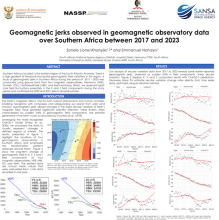Geomagnetic jerks observed in geomagnetic observatory data over Southern Africa between 2017 and 2023.
Sanele Lionel
Khanyile
South African National Space Agency
Poster
Geomagnetic jerks are jumps observed in the second derivative of the main magnetic field that occur on annual to decadal timescales. Understanding these jerks is crucial as they provide valuable insights into the complex dynamics of the Earth’s outer liquid core. In this study, we investigate the occurrence of geomagnetic jerks in geomagnetic observatory data collected at southern African magnetic observatories, Hermanus (HER), Tsumeb (TSU), Hartebeesthoek (HBK) and Keetmanshoop (KMH) between 2017 and 2023. The observatory data was processed and analyzed by retaining quiet night-time data recorded during quiet geomagnetic activities with the help of Kp, Dst and ring current RC indices. Results confirm the occurrence of 2019-2020 geomagnetic jerk in the region and identify the recent 2021 jerk detected with V-shaped secular variation changes in X and Z components at all four observatories. The highest estimated 2021 jerk secular acceleration amplitudes in X and Z components were found at HBK, 12.7 nT/year^2 and 19. 1 nT/year^2, respectively. Notably, the global CHAOS-7 model aptly identifies this 2021 jerk in the Z component at all magnetic observatories in the region.
Keywords: Geomagnetic jerks, secular variation, magnetic observatory data, South Atlantic Anomaly
Keywords: Geomagnetic jerks, secular variation, magnetic observatory data, South Atlantic Anomaly

Poster PDF
Poster category
Geospace/Magnetosphere Research and Applications
Poster session day
Poster location
14
Meeting homepage